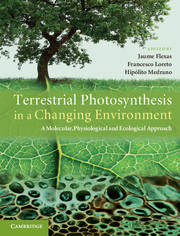 Terrestrial Photosynthesis in a Changing Environment
Terrestrial Photosynthesis in a Changing Environment Published online by Cambridge University Press: 05 March 2013
The Development of Gas-Exchange Systems and their Practical Applications
Gas-exchange systems have come a long way since the technology for real-time measures of gas concentrations in air became available. The method of choice among most plant biologists involves the use of IR gas analysers (IRGAs) integrated into gas-exchange systems to measure concentrations of CO2 taken up by photosynthesis and water released via transpiration (E) over a range of conditions that can be manipulated by the researcher. Typically, gas-exchange systems rely on steady state conditions surrounding photosynthetic tissues, however, unique systems have been developed to measure non-steady state gas exchange for rapid responses (e.g., seconds and faster) to changing conditions (e.g., Laisk and Oja, 1998). Less common, but never-the-less available and quite useful, are methods that rely on oxygen analysers to measure photosynthetic oxygen release. Furthermore, there are methods for determining rates of photosynthesis that rely on Chl-F, reflective indices (e.g., photochemical reflectance index, PRI) and isotopic analysis, each of which are discussed in other chapters. The objective of this chapter is to present and discuss the current methods specific to gas exchange for measuring photosynthesis. This objective includes discussions on the current state of technology, a summary of the equations and theories behind the measurements, potential sources of error and the variables of interest that can be extracted from the most common measurements. Although the focus of this chapter is to provide an ‘entry point’ into the common gas-exchange techniques, it is not intended to provide a complete description of all gas-exchange systems and all physiologically meaningful data that can be collected. Rather, the reader is recommended towards a wide variety of excellent texts that detail many aspects of gas exchange (e.g., Long and Hällgren, 1993; Laisk and Oja, 1998; Long and Bernacchi, 2003).
To save this book to your Kindle, first ensure [email protected] is added to your Approved Personal Document E-mail List under your Personal Document Settings on the Manage Your Content and Devices page of your Amazon account. Then enter the ‘name’ part of your Kindle email address below. Find out more about saving to your Kindle.
Note you can select to save to either the @free.kindle.com or @kindle.com variations. ‘@free.kindle.com’ emails are free but can only be saved to your device when it is connected to wi-fi. ‘@kindle.com’ emails can be delivered even when you are not connected to wi-fi, but note that service fees apply.
Find out more about the Kindle Personal Document Service.
To save content items to your account, please confirm that you agree to abide by our usage policies. If this is the first time you use this feature, you will be asked to authorise Cambridge Core to connect with your account. Find out more about saving content to Dropbox.
To save content items to your account, please confirm that you agree to abide by our usage policies. If this is the first time you use this feature, you will be asked to authorise Cambridge Core to connect with your account. Find out more about saving content to Google Drive.